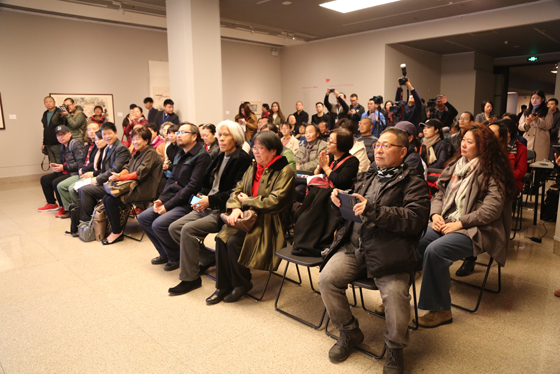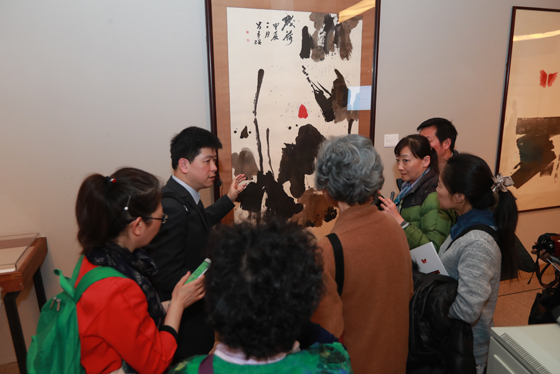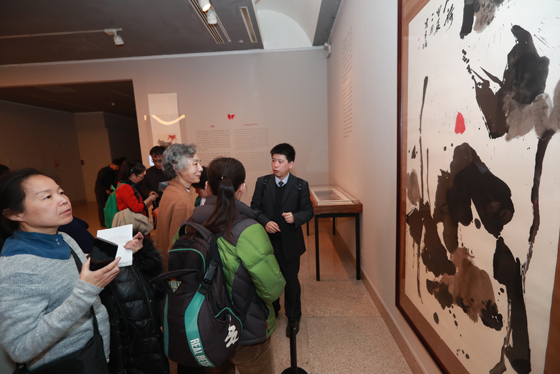“The New Ink Painting Movement” in Hong Kong: Experimentation of Chinese Painting NAMOC Exhibited the Ink and Wash Paintings of Artist LuiShou-Kwan
Source:: Time:2018年03月22日
"In Search of Zen – The Art of LuiShou-Kwan", co-sponsored by National Art Museum of China (NAMOC) and Art Museum of the Chinese University of Hong Kong, opened on March 16, 2018, in NAMOC. The exhibition selected 51 pieces of the most representative works of LuiShou-Kwan, which created from the late 1940s to the early 1970s, from Art Museum of Chinese University of Hong Kong and Hong Kong Museum of Art, demonstrating his the masterpieces which have taken root in the tradition and broke through the barriers between China and Western countries’ culture.
The exhibition originated in 2015. Mr. Wu Weishan, Director of NAMOC, and Mr. Shen Zuyao, President of the Chinese University of Hong Kong, signed the Exchange Agreement between National Art Museum of China and Chinese University of Hong Kong. The two sides will work hard to exchange and collaborate to promote the cooperation in the field of art. Under the framework of the agreement, the two parties will promote mutual exchanges among scholars, jointly organize academic and public education seminars, and advance art research cooperation and a series of artistic exchange activities.
LuiShou-Kwan (1919-1975) was recognized as the pioneer of the “New Ink Painting” movement in Hong Kong. He made great achievements in the art arena of Hong Kong in 1960s. He was also praised and affirmed by famous European and American art critics. He has received good education in culture and fine arts since childhood. In addition to being proficient in Chinese ancient painting theory, he has also copied classics of ancient masters, such as Figure of Fisherman created by Wu Zhen and Spring Breeze and Pavilion of the Lake produced by Ni Zan. At the same time, he has been familiar with Western art theories, including the Meaning of Art written by Sir Herbert Read and Modern American Painting and Sculpture written by Sam Hunter. He has also been concerned about the development of American art after the war. With a profound understanding of Chinese traditional art and Western contemporary art, he has developed a new style of Chinese ink and wash painting, which not only retains the traditional values of Chinese painting, but also blends modern artistic creation and Hong Kong cultural feelings, opening the “Ink Painting Movement” in Hong Kong. He published his book Research of Chinese Painting in 1957, showing readers the Chinese painting tradition which has been used by modern art and successfully carrying forward the experimental aspects of Chinese painting.
The Hong Kong Ink Painting Movement promoted by LuiShou-Kwan and other Hong Kong artists also made a certain influence on the development of ink painting in mainland China in 1980s. This exhibition has made the art world of LuiShou-Kwan accessible to the Mainland public, revealing his national heritage and international perspectives, and contributing to the promotion of modern ink and wash art. It has also presented the development of the Ink Painting Movement.
The enthusiasm for art throughout his life is not only demonstrated in his rich and varied works, but also in the story Encounter with a Monk written by him. Prior to becoming famous, LuiShou-Kwan had made a strong struggle between artistic pursuit and family responsibility, therefore, he wrote the story that he encountered a monk in his dream. In order to describe his own experiences and understanding, Art Museum of Chinese University of Hong Kong, together with School of Journalism and Communication of Chinese University of Hong Kong, used the lens and the picture to reproduce the plot of Encounter with a Monk and to display its originality, allowing the public in the Mainland to understand his artistic life from multiple perspectives. This short film was shot by a young Hong Kong director, and has honoredly invited the students of LuiShou-Kwan and renowned designer Dr. Kan Tai-keung to perform with young dancers, which presents the meaning of heritage.
The exhibition will be on display at Hall 19-21 of NAMOC until April 14 (closed on Mondays).
The exhibition originated in 2015. Mr. Wu Weishan, Director of NAMOC, and Mr. Shen Zuyao, President of the Chinese University of Hong Kong, signed the Exchange Agreement between National Art Museum of China and Chinese University of Hong Kong. The two sides will work hard to exchange and collaborate to promote the cooperation in the field of art. Under the framework of the agreement, the two parties will promote mutual exchanges among scholars, jointly organize academic and public education seminars, and advance art research cooperation and a series of artistic exchange activities.
LuiShou-Kwan (1919-1975) was recognized as the pioneer of the “New Ink Painting” movement in Hong Kong. He made great achievements in the art arena of Hong Kong in 1960s. He was also praised and affirmed by famous European and American art critics. He has received good education in culture and fine arts since childhood. In addition to being proficient in Chinese ancient painting theory, he has also copied classics of ancient masters, such as Figure of Fisherman created by Wu Zhen and Spring Breeze and Pavilion of the Lake produced by Ni Zan. At the same time, he has been familiar with Western art theories, including the Meaning of Art written by Sir Herbert Read and Modern American Painting and Sculpture written by Sam Hunter. He has also been concerned about the development of American art after the war. With a profound understanding of Chinese traditional art and Western contemporary art, he has developed a new style of Chinese ink and wash painting, which not only retains the traditional values of Chinese painting, but also blends modern artistic creation and Hong Kong cultural feelings, opening the “Ink Painting Movement” in Hong Kong. He published his book Research of Chinese Painting in 1957, showing readers the Chinese painting tradition which has been used by modern art and successfully carrying forward the experimental aspects of Chinese painting.
The Hong Kong Ink Painting Movement promoted by LuiShou-Kwan and other Hong Kong artists also made a certain influence on the development of ink painting in mainland China in 1980s. This exhibition has made the art world of LuiShou-Kwan accessible to the Mainland public, revealing his national heritage and international perspectives, and contributing to the promotion of modern ink and wash art. It has also presented the development of the Ink Painting Movement.
The enthusiasm for art throughout his life is not only demonstrated in his rich and varied works, but also in the story Encounter with a Monk written by him. Prior to becoming famous, LuiShou-Kwan had made a strong struggle between artistic pursuit and family responsibility, therefore, he wrote the story that he encountered a monk in his dream. In order to describe his own experiences and understanding, Art Museum of Chinese University of Hong Kong, together with School of Journalism and Communication of Chinese University of Hong Kong, used the lens and the picture to reproduce the plot of Encounter with a Monk and to display its originality, allowing the public in the Mainland to understand his artistic life from multiple perspectives. This short film was shot by a young Hong Kong director, and has honoredly invited the students of LuiShou-Kwan and renowned designer Dr. Kan Tai-keung to perform with young dancers, which presents the meaning of heritage.
The exhibition will be on display at Hall 19-21 of NAMOC until April 14 (closed on Mondays).

W020180317604692617745

W020180317604692679689

W020180317604692683282

